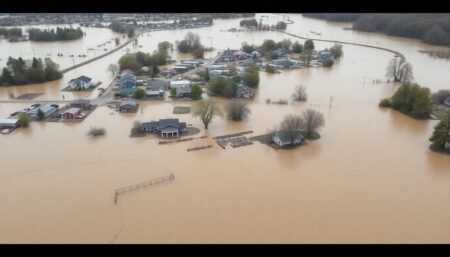In recent years, the question on everyone’s mind has been: are major natural disasters increasing? The answer, according to data from the National Oceanic and Atmospheric Administration (NOAA), is a resounding yes. Since 1980, the United States has experienced 286 weather and climate disasters where losses exceeded $1 billion, totaling nearly $2 trillion in damages. This alarming trend has led many to wonder if this is a new normal, or a harbinger of things to come.
Climate change, with its impact on weather patterns and sea levels, is often cited as a significant factor in this increase. The frequency and intensity of hurricanes, wildfires, and other extreme weather events have been on the rise, leaving many communities devastated and billions of dollars in damages in their wake. But what can we do to prepare for these events? That’s where this article comes in.
Our purpose today is to explore the reality of increasing natural disasters, understand the most affected states, and most importantly, provide you with a comprehensive guide on how to prep and survive these situations. By the end of this article, you’ll have a clear understanding of the risks, the steps you can take to mitigate them, and how to build a resilient community. So, let’s dive in and ensure that when the next big one hits, you’re ready.
But first, let’s take a closer look at the data and the states most affected by these billion-dollar natural disasters.
From 3.3 per year in the 1980s to 17+ from 2014–2023: How to Prepare for a World of More Frequent and Costly Disasters
From 3.3 per year in the 1980s to 17+ from 2014–2023: How to Prepare for a World of More Frequent and Costly Disasters

The Rising Tide of Billion-Dollar Disasters
In recent years, the United States has been grappling with an alarming trend: the increasing frequency and cost of billion-dollar natural disasters. According to the National Oceanic and Atmospheric Administration (NOAA), the U.S. has experienced 28 billion-dollar weather and climate disasters in the past five years alone, totaling over $900 billion in damages.
The year 2020 was a stark example of this trend, with 22 separate billion-dollar disasters, including hurricanes, wildfires, and derechos. The costliest of these was Hurricane Harvey, which caused an estimated $125 billion in damages to Texas and Louisiana.
Several factors contribute to this disturbing trend. Firstly, there’s increased exposure, as more people choose to live in high-risk areas like coastal regions and wildfire-prone zones. Secondly, our vulnerability grows as our infrastructure ages and becomes more interconnected, leading to cascading failures during disasters.
However, the most significant driver of these catastrophic events is climate change. Rising temperatures are fueling more intense and frequent heatwaves, droughts, and wildfires. They’re also contributing to more powerful hurricanes and heavier rainfall events, leading to increased flooding. Warmer ocean temperatures, in turn, are causing more frequent and severe marine heatwaves, which can devastate coastal ecosystems.
To prepare for these escalating threats, it’s crucial for individuals, communities, and governments to take proactive measures. This includes investing in resilient infrastructure, implementing early warning systems, and promoting climate-smart practices. Moreover, it’s essential to support policies that mitigate climate change, such as transitioning to renewable energy and preserving natural carbon sinks like forests and wetlands.
In the meantime, individuals can take steps to prep for these situations. This might involve creating an emergency plan, building an emergency supply kit, and ensuring that important documents are easily accessible. By taking these proactive measures, we can better protect ourselves, our families, and our communities from the rising tide of billion-dollar disasters.

The Cost of Disaster: What’s Included and What’s Not
The Cost of Disaster: What’s Included and What’s Not

The Deadliest Disasters: Tropical Cyclones and Droughts
The Deadliest Disasters: Tropical Cyclones and Droughts

Disaster Hotspots: Which States Are Most Affected?
The United States, with its vast and diverse geography, is no stranger to natural disasters. According to the National Oceanic and Atmospheric Administration (NOAA), the U.S. has experienced 285 weather and climate disasters since 1980 where the losses exceeded $1 billion. Let’s delve into the states that have been most affected and the unique hazards they face.
The top spot goes to Texas, with a staggering 238 billion-dollar disasters since 1980. Texas’ size and diverse geography make it vulnerable to a wide range of hazards. It faces severe thunderstorms, hurricanes, droughts, wildfires, and extreme temperatures. The historical costs incurred by Texas are estimated to be over $300 billion.
California comes in a close second with 197 billion-dollar disasters. California’s Mediterranean climate and topography make it susceptible to wildfires, droughts, floods, and earthquakes. The state has incurred over $200 billion in damages.
Florida, with its coastal location and warm climate, is the third most affected state. Florida faces hurricanes, tropical storms, floods, and severe thunderstorms. The Sunshine State has experienced over 120 billion-dollar disasters, with total costs exceeding $100 billion.
Other states that make the top ten list include:
- J Louisiana, with 95 billion-dollar disasters, primarily due to hurricanes and floods.
- K Pennsylvania, with 87 billion-dollar disasters, mainly from severe thunderstorms and winter storms.
- L New York, with 82 billion-dollar disasters, including hurricanes, winter storms, and severe thunderstorms.
- M Oklahoma, with 79 billion-dollar disasters, primarily from severe thunderstorms, tornadoes, and wildfires.
Understanding these geographic distributions and unique hazards can help individuals and communities better prepare for and mitigate the impacts of natural disasters.

Funding the Response: How Disaster Relief Works
Disaster relief efforts in the United States are a multi-layered endeavor, involving local, state, and federal levels of government, each playing a crucial role in ensuring a swift and effective response to natural disasters. The process begins at the local level, where first responders, such as police, fire, and emergency medical services, are the first to arrive on the scene. These local heroes are often funded through property taxes and local government budgets, ensuring they have the necessary resources to provide immediate assistance.
The state government also plays a significant role in disaster relief. State emergency management agencies coordinate with local authorities, providing additional resources and support. State funding comes from various sources, including state budgets, grants, and fees. For instance, many states impose surcharges on certain services, like telephone bills, to fund emergency preparedness and response efforts.
At the federal level, the Federal Emergency Management Agency (FEMA) is the lead agency responsible for coordinating the federal government’s response to disasters. FEMA’s funding comes primarily from the federal budget, with the majority allocated to the Disaster Relief Fund (DRF). The DRF is used to provide financial assistance to individuals and households, as well as to support state and local governments in their response and recovery efforts.
When a disaster strikes, the governor of the affected state typically declares a state of emergency, which allows the state to access federal resources. If the governor determines that the state’s resources are insufficient to respond to the disaster, they can request a presidential disaster declaration. If approved, the president can make federal funding available to supplement state and local efforts.
The increasing frequency and severity of natural disasters have led to a corresponding increase in federal funding for disaster relief. According to the Congressional Research Service, the federal government spent over $356 billion on disaster relief between 2005 and 2019. This trend is expected to continue, as climate change makes natural disasters more frequent and intense.
In conclusion, disaster relief efforts in the United States are a complex and coordinated effort involving local, state, and federal governments. Each level of government plays a critical role in ensuring a swift and effective response to natural disasters. As disasters become more frequent and severe, it is essential that we continue to invest in and strengthen our disaster relief systems to ensure that we are prepared to protect and support our communities in their time of need.

Prepping for the Inevitable: How to Survive the Next Big One
Prepping for the Inevitable: How to Survive the Next Big One

Building Resilience: Community and Self-Sufficiency
Building Resilience: Community and Self-Sufficiency









